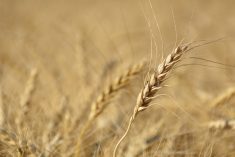Fed prices steady
Average fed steer and heifer prices were fairly steady last week, up 25 cents per hundredweight on steers and down slightly on heifers.
Most trade took place mid-week, said Canfax.
Volume reported by Canfax members was slightly more than 27,500 head, up 19 percent from the week before.
Packers maintained a long inventory position.
The set-aside program saw more activity with 169 registered bidders and 29 participants bidding.
The weighted average feed cost for this set-aside was $1.44 per head per day. Cattle were accepted from Alberta, Saskatchewan and Ontario.
Read Also

Chinese offer complicates canola marketing
Recently the Chinese ambassador indicated that there would be a potential deal between Canada and China regarding the current tariff war.
Alberta prices Oct. 28, in limited trade, were steers live $79-$81.50 per cwt., steers rail $133.15-$132.25 and heifers $81.50.
Given their large inventory, packer appetite this week will likely be sluggish, said Canfax.
Supplies of fed cattle in the near term are not expected to change substantially so market tone will likely be the same.
Canadian heavy AAA cutout gained $2.61 per cwt. two weeks ago, while other cutouts were steady to lower by 50 cents per cwt. U.S. cutouts last week were down $1.75-$3.50 US, seven to 16 percent lower than a year ago.
Canfax said the Calgary wholesale market held steady to slightly stronger, trading between $141-$145 Cdn. Renderings lost some ground, pulling the drop credits to $95-$101.
Calf run booms
Feeder cattle volumes exploded with about 97,500 head moving through Alberta auction markets, up 41 percent from the week before and 19 percent higher than a year ago.
Most of the volume consisted of calves with prices steady to stronger on lighter weights because of news that a deal was made between the United States and Japan.
Steers 300-500 lb. were $2.50-$4.50 per cwt. higher while 500-900 lb. were 25-50 cents lower. Steers 900 lb. and heavier on lighter volumes and lower quality were down $1.25.
Heifers 300-500 lb. traded $2-$3 stronger, while 500-600 lb. were steady. Heifers 600-800 lb. were down $1-$2 and 900 lb. and heavier were steady to 25 cents lower.
D1, 2 cows held steady, but butcher bulls were down $1.50.
Canfax expects large volumes again this week with lots of calves. A few yearlings will trickle in, but quality may become an issue.
Prices will continue to vary widely depending on location of auction market and buyer depth of the day, Canfax said.
Stock bred cows in northern and central Alberta traded between $300-$725, while bred heifers in those regions were $340-$725.
Cow-calf pairs in northern Alberta were $390-$790 depending on age of the cow and quality.
Cattle futures prices fell last week on worries about large supplies of market ready and almost ready cattle. The agreement between the U.S. and Japan on resuming beef trade had little effect on futures, with traders believing the deal will not generate significant exports until the second half of 2005.
Hog price dips
Hog prices edged slightly lower last week and the strong loonie made the effect more pronounced in Canada.
The weekly average Iowa-Minnesota daily direct hog price (Thursday to Thursday, 51-52 percent lean carcass converted to live weight) was about 1.5 percent lower at $53.90 US per cwt. on Oct. 28. Manitoba Agriculture said slaughter plants in that province set an annual record two weeks ago, killing 87,094 hogs.
Manitoba weanling prices continue to rise as the industry sorts out the effects of the anti-dumping duty. In Manitoba, the spot price for five kilogram weanling pigs was up about 4.5 percent, for the week ending Oct. 22. The spot price for 23 kg weanlings rose 5.5 percent. The top bids for the spot prices were higher than the top bids for contract prices for the second week in a row, said Manitoba Agriculture.
Ron Plain of the University of Missouri said hog prices usually weaken from October to November.
“This is the most likely possibility for this year. But if the current live demand can be held and slaughter on a weekly basis is not up more than one to two percent as we go through November, terminal hog prices are likely to bottom in the mid to upper $40s US for the fall of 2004.”
Lambs, sheep steady
Ontario Stockyards reported 2,770 sheep and lambs and 528 goats sold.
All classes of lambs and sheep traded steady. Goat fell as much as $20 Cdn.














